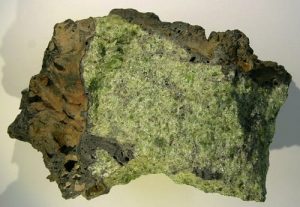During the three-year research project CO2MIN, HeidelbergCement and RWTH Aachen University will explore the absorption of CO2 from flue gas by the minerals olivine and basalt. In the future, the carbonised minerals could be used as a value-added additive in the production of building materials. HeidelbergCement and RWTH are supported by the Potsdam Institute for Advanced Sustainability Studies (IASS) and the Dutch start-up Green Minerals.

The minerals olivine (photo by Hannes Grobe) and basalt (see header image) are able to bind CO2.
The natural minerals olivine and basalt are able to bind CO2 over their entire life-cycle. With natural absorption, it takes decades until the minerals are saturated with the greenhouse gas. The research project intends to speed up the absorption process. If successful, carbonised minerals can be used for various product applications.
The use of CO2 as a raw material has high priority in the climate strategy of HeidelbergCement. “We are already reducing the CO2 emissions of our plants very successfully by using alternative fuels and raw materials and by optimising the efficiency of our kilns,” explains Jan Theulen, Director of Alternative Resources at HeidelbergCement. “In order to reduce CO2 emissions even further in the future, we have to develop and test new approaches. One of them is the binding of CO2 by minerals.”
In the first year the research focuses on the investigation of different minerals in small-scale experiments. The carbonation of the most suitable minerals will be tested under realistic process conditions in the following year. The experiments will be conducted by the institute of Process Metallurgy and Metal Recycling (IME), which also is the coordinator of the RWTH group. Life-cycle assessments (RWTH) as well as analyses of economic aspects and social acceptance (IASS) complete this project phase. In the third year, marketability and acceptance will be further optimised through intensive cooperation with customers.

















